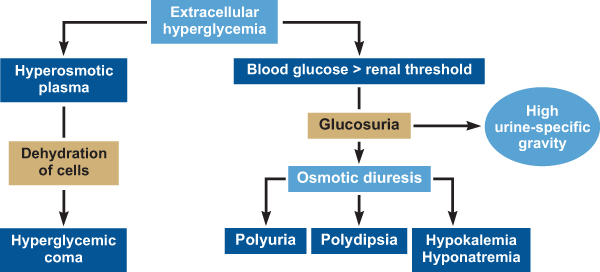
Clinical signs of hypoglycemia include weakness lethargy poor appetite altered mentation twitching tremoring seizures and coma. Clinical signs of hypoglycemia include weakness lethargy poor appetite altered mentation twitching tremoring seizures and coma.

In puppies with hyperglycemia and juvenile onset diabetes you may notice a loss of weight despite your puppy eating just about everything you feed.
Signs of hyperglycemia in puppies. This increases the acidity within the body and causes an imbalance of fluids and minerals. As with hyperglycemia dogs will have increased thirst and urination. Additional symptoms include weakness lethargy decreased appetite vomiting weight loss and muscle wasting dehydration and increased respiration.
In puppies with hyperglycemia and juvenile onset diabetes you may notice a loss of weight despite your puppy eating just about everything you feed her. She may have been the smallest puppy in the litter. She may experience limb weakness or paralysis if.
Stress cold malnutrition and intestinal parasites also may trigger juvenile hypoglycemia. Signs of hypoglycemia are loss of appetite extreme lethargy lack of coordination trembling muscle twitching weakness seizures and discoloration of skin and gums. Most dogs will not eat or drink when they are in low sugar shock.
Nerve damage in legs. Severe depression in cases of extremely high blood sugar level levels. Infection is increased as the excess sugar feeds fungal and bacterial invaders.
Tissue damage due to oxidizing burning effect of the excess sugar in the tissue. In puppies certain situations can bring on a hypoglycemic attack. For example when the puppy misses a meal becomes chilled or is suffering from exhaustion or anxiety.
Sometimes when a puppy gets older she will outgrow this condition since canine hypoglycemia mostly affects puppies 5 to 16 weeks of age. Clinical signs of hypoglycemia include weakness lethargy poor appetite altered mentation twitching tremoring seizures and coma. If left untreated hypoglycemia will be fatal.
If an owner suspects hypoglycemia they can help to increase blood sugar by rubbing a small amount of Karo syrup on the gums. Clinical signs of this syndrome include weakness inappetence peripheral neuropathy hindlimb paralysis retinal disease lipemia retinalis tachycardia and tachypnea resulting from anemia. Congenital hypothyroidism with hypercholesterolemia has been reported in puppies and kittens.
To handle hypoglycemia in a young puppy feed it as soon as you notice symptoms which may raise its blood glucose to a healthy level. If your puppy wont eat get a liquid sugar source like maple syrup or molasses and rub 1-2 tablespoons of it into your puppys gums or underneath its tongue. Hypoglycemia is a condition also known as low blood sugar.
The normal blood sugar in dogs is between 80 and 150 milligrams per deciliter mgdl of blood. When the values fall below the normal values the dog will suffer from hypoglycemia. The symptoms of hypoglycemia include shaking seizures or even coma.
Feline Diabetes For Dummies. Watch closely and learn the signs of early HYPERglycemia. This could be PUPD or more nebulous signs.
This could be PUPD or more nebulous signs. For Darlenes cat Pooter one fairly reliable early sign of insufficient insulin is bloodshot eyes. Signs and symptoms of hyperglycemia in dogs Elevated glucose levels may also be indicative of pre-diabetes or diabetes in dogs.
The clinical signs observed in hyperglycemia in dogs can resemble canine diabetes so it is important to make sure that your dog is appropriately tested to find the true cause of its elevated glucose. Hypoglycemia is a real threat to these tiny puppies watch for your puppy to become tired or droopy. The first signs are those of listlessness and depression.
They are followed by muscular weakness tremors and later convulsions coma and even death. The puppy may appear depressed or may be weak wobbly and jerky or the puppy may be found in a coma. Breeders also are encouraged to include information about hypoglycemia in packets they send with puppies going to new homes.
Sharing information may help save a dogs life. Persistent hyperglycemia and presence of characteristic clinical signs. Documentation of an elevated serum fructosamine concen-tration may be necessary to confirm the diagnosis in cats9 Fruc-tosamine levels may be only mildly elevated with lower levels of persistent hyperglycemia and should be interpreted as part of a complete evaluation9.
If the insulin dose is too high clinical signs of hypoglycemia may be observed. Hypoglycemia may also be triggered by events causing a relative insulin overdose. The clinical signs of hypoglycemia in increasing order of severity are.
Very quiet and inappetent. In puppies with hyperglycemia and juvenile onset diabetes you may notice a loss of weight despite your puppy eating just about everything you feed. Considering taking medication to treat hyperglycemia.
Below is a list of common medications used to treat or reduce the symptoms of hyperglycemia. Warning signals in dogs. Inflamation of the eye blood vessels in dogs is an indication of hypoglycemia.
In both hypoglycemia and hyperglycemia the whites of the eye become reddened and appear quite irritated. The difference is best likened to the difference in the color of venous blood and arterial blood. Clinical Signs of Feline Hypoglycemia.
The clinical signs of hypoglycemia that cat owners should be able to recognize are in order of severity. Its important to alert your cat-owning clients that early signs of hypoglycemia may be subtle. Hyperglycemia High Blood Sugar in Cats.
Signs Symptoms and Causes Sandra Wilson Diabetes in Pets May 30 2018 Its important to remember that just like humans some animals are susceptible to hyperglycemia and can be at risk of developing diabetes.